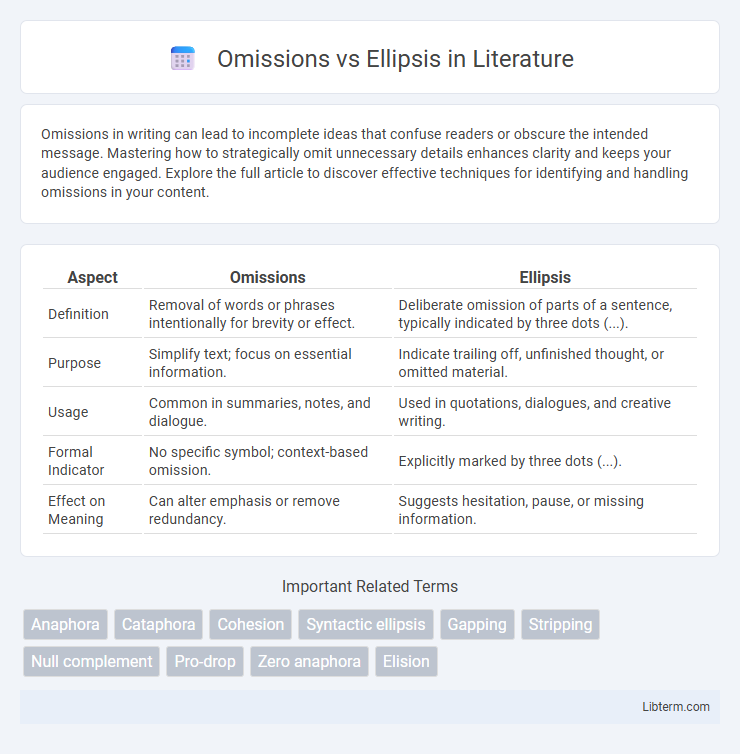Omissions in writing can lead to incomplete ideas that confuse readers or obscure the intended message. Mastering how to strategically omit unnecessary details enhances clarity and keeps your audience engaged. Explore the full article to discover effective techniques for identifying and handling omissions in your content.
Table of Comparison
| Aspect | Omissions | Ellipsis |
|---|---|---|
| Definition | Removal of words or phrases intentionally for brevity or effect. | Deliberate omission of parts of a sentence, typically indicated by three dots (...). |
| Purpose | Simplify text; focus on essential information. | Indicate trailing off, unfinished thought, or omitted material. |
| Usage | Common in summaries, notes, and dialogue. | Used in quotations, dialogues, and creative writing. |
| Formal Indicator | No specific symbol; context-based omission. | Explicitly marked by three dots (...). |
| Effect on Meaning | Can alter emphasis or remove redundancy. | Suggests hesitation, pause, or missing information. |
Understanding Omissions and Ellipsis
Omissions involve leaving out words or phrases that are implied by context, enhancing brevity without losing meaning. Ellipsis specifically refers to the deliberate omission of one or more words from a sentence, replaced by three dots (...) to indicate the missing content. Recognizing omissions and ellipses helps in interpreting text by understanding the unstated information essential for full comprehension.
Defining Omissions in Writing
Omissions in writing refer to the deliberate exclusion of words or phrases that can be inferred from context without hindering comprehension, enhancing brevity and clarity. This technique allows authors to avoid redundancy by omitting predictable or implied elements, such as subjects or verbs, particularly in dialogue and informal prose. Effective use of omissions streamlines communication while maintaining semantic integrity, distinguishing it from ellipsis, which specifically uses punctuation to indicate omitted text.
What is Ellipsis?
Ellipsis is a linguistic phenomenon where one or more words are omitted from a sentence because they are implied by the context, ensuring the sentence remains grammatically correct and easily understood. It commonly occurs in conversational English, such as in responses where the verb or subject is left out but understood, for example, "Want to come?" instead of "Do you want to come?" Ellipsis improves communication efficiency by reducing redundancy while maintaining clear and coherent meaning.
Key Differences Between Omissions and Ellipsis
Omissions involve leaving out words or phrases that are implied but not necessary for understanding, often resulting in incomplete sentences, whereas ellipsis specifically refers to the deliberate omission of words replaced by three dots (...) to indicate missing text. Omissions are broader and can include grammatical or contextual gaps, while ellipsis is a standardized punctuation mark used to show trailing off or skipped content. The key difference lies in omissions being a general grammatical phenomenon, while ellipsis is a specific stylistic device with clear punctuation rules.
Functions of Omissions in Sentences
Omissions in sentences serve to streamline communication by removing redundant or predictable elements, enhancing brevity without losing meaning. They facilitate focus on key information, improve readability, and create a more natural flow in spoken and written language. Functions of omissions include the elimination of repeated subjects, verbs, or objects, allowing sentences to avoid unnecessary repetition and maintain clarity.
The Role of Ellipsis in Communication
Ellipsis serves as a powerful linguistic tool that enhances communication by allowing speakers to omit redundant information while maintaining clarity and coherence in discourse. This strategic omission streamlines conversations, making interactions more efficient and context-dependent, as listeners infer the missing elements based on shared knowledge. In contrast to general omissions, ellipsis relies on grammatical and contextual cues to preserve meaning, thereby facilitating smoother and more natural exchanges in both spoken and written language.
Common Examples of Omissions and Ellipsis
Common examples of omissions include leaving out articles, auxiliary verbs, or prepositions when the context is clear, such as saying "She going to store" instead of "She is going to the store." Ellipsis often appears in dialogues or comparative sentences, like "I ordered the salad, and he the soup," where the verb "ordered" is omitted to avoid repetition. Both omissions and ellipses streamline communication by reducing redundancy while maintaining clarity.
Grammar Rules for Using Ellipsis
Ellipsis in grammar involves the intentional omission of words that are implied by the context, enhancing sentence conciseness without sacrificing meaning. The primary rule for using ellipsis is ensuring clarity; omitted words must be easily inferred from the surrounding text to maintain the coherence of the sentence. Ellipses are often marked by three dots (...) to indicate missing content, but it is crucial not to remove essential grammatical elements that would render the sentence ambiguous or incomplete.
Avoiding Ambiguity: Omissions vs Ellipsis
Omissions remove words entirely, risking ambiguity when key elements are missing, while ellipsis uses three dots (...) to indicate omitted text without losing essential meaning. Proper use of ellipsis preserves clarity by signaling intentional gaps, preventing misinterpretation in written communication. Avoid ambiguous omissions by ensuring that critical information remains clear and contextually supported.
Best Practices for Clear Writing
Omissions and ellipsis serve distinct roles in writing; omissions remove unnecessary words to enhance clarity, while ellipsis indicates the intentional omission of text for brevity or suspense. Best practices encourage using omissions to eliminate redundancy without sacrificing meaning and applying ellipsis sparingly to avoid confusing readers. Maintaining reader comprehension requires balancing concise expression with sufficient context to ensure clear communication.
Omissions Infographic

 libterm.com
libterm.com